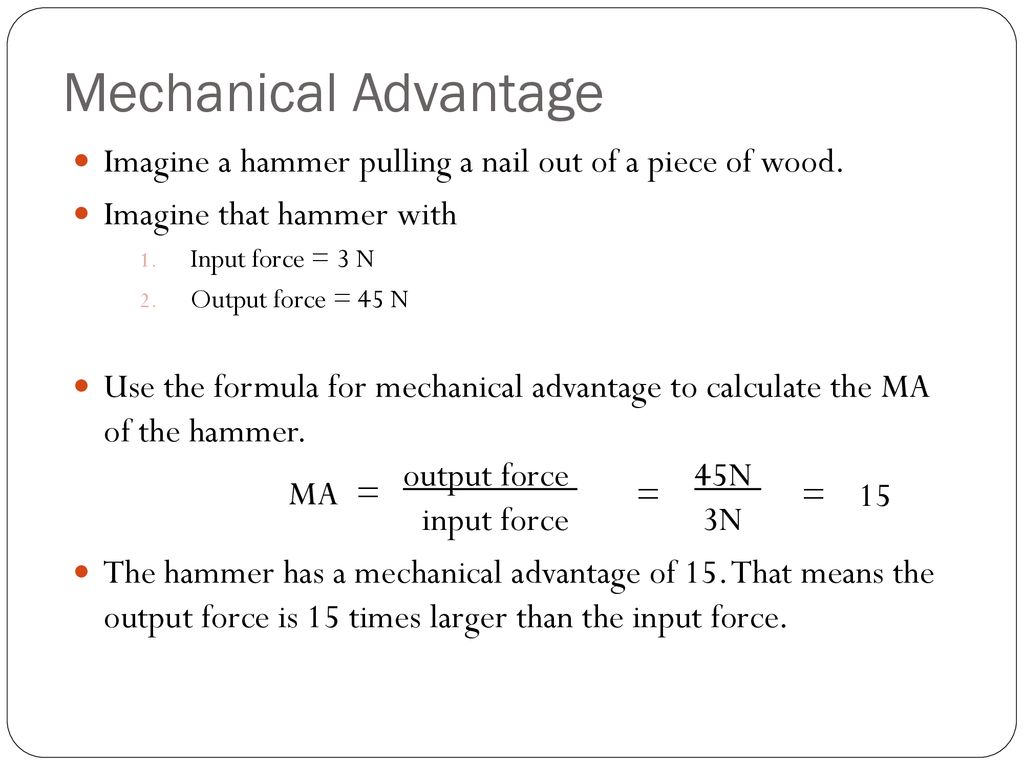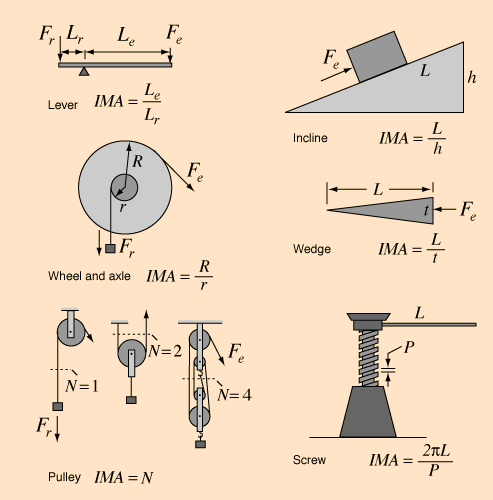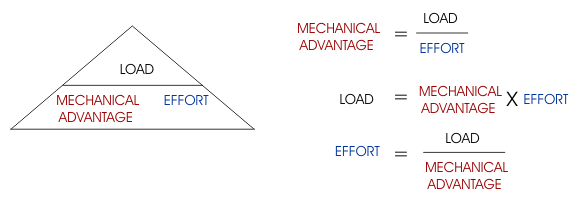Mechanical Advantage Can Be Defined as the Ratio of
The ratio of the resistance force to the effort force. The ratio of the force that performs the useful work of a machine to the force that is applied to the machine.

What Is The Mechanical Advantage Of A Machine Ppt Download
The advantage gained by the use of a mechanism in transmitting force specifically.

. Efficiency of a machine is defined as the ratio of output work to the input work. The mechanical advantage of different simple machines like a lever wedge inclined plane wheel axle etc. If we need a force of 100N to do a work in a single movable pulley system we need only 50N or half the force.
Mechanical advantage can be defined as the ratio of the output force to the input forceIdeal mechanical advantage means the mechanical advantage without friction. Mechanical advantage can be defined as thew ratio of. The ratio of work output to work input or the ratio of AMA to IMA.
Therefore M e c h a n i c a l A d v a n t a g e O u t p u t f o r c e I n p u t f o r c e quad text Mechanical Advantage left frac text Output force text Input force right Mechanical Advantage Input forceOutput force. Can be derived following the definition of the mechanical advantage given above. Thus if W is the load and P is the corresponding effort then.
See answer 1 Best Answer. Mathematically it can be written as. 18 teeth driving 6 teeth is 186 31 31 Note for Teacher.
Typically the mechanical advantage is expressed in ideal terms where there is no. Mechanical advantage of machine is defined as the ratio of load lifted at output end to the effort applied at the input end of the machine. With the help of a machine a small force can be applied to move a much greater resistance or load.
Under mechanical advantage the distance the load will be moved will be only be a fraction of the distance through which the effort is applied. Torque force x distance. It is a unitless expression since the two ratio quantities are the force.
It is the ratio of output force to the input force. For performing any particular work we make use of the machines. In machines that transmit only mechanical energy the ratio of the force exerted by the machine to the force applied to the machine is known as mechanical advantage.
It can also define as the ratio of input arm distance to the output arm distance. This is the ratio of load lifted to effort applied. What is mechanical advantage.
In the case of an ideal frictionless and weightless machine mechanical advantage velocity ratio. What is the equation for torque. It gives the ratio between the force applied to the load and the force needed to overcome the given force.
Definition of mechanical advantage. A mechanical advantage is a form of calculation that measures the amplified force taken by the mechanical system. Mechanical advantage also called force ratio is the ratio of the output force load of a machine to the input force effort.
- The ability to preform more work with less effort. Definitions of mechanical advantage. The ratio of the force exerted by a machine to the force applied to it.
Mechanical advantage is actually the ratio of input force to output force. As the structure and operation of these machines vary hence they have specific formulas for themselves. For a lever the ratio of the perpendicular distance of the line of action of the effort from the fulcrum to the perpendicular distance of the line of action of the resistance or load from the fulcrum.
Explain that this ratio can also be determined by the number of teeth. The mechanical advantage of any machine is defined as the ratio of output force to the input force. In the following section under Related Study I have given.
The applied force must move through a much greater distance. The mechanical advantage of a given machine is the factor by which it multiplies any applied force. Mechanical advantage is a measure of the ratio of output force to input force in a system used to analyze the forces in simple machines like levers and pulleys.
For a single movable pulley the ideal mechanical advantage is 2 ie. The gear ratio not only determines the number of revolutions it also determines the output of force or the mechanical advantage. What is the equation for mechanical advantage.
Where are output force and input force respectively. The number of times the effort force could theoretically be multiplied neglecting friction. Mechanical Advantage fracWP There is no change in velocity ratio or mechanical advantage of a simple machines with the change in friction.
If the mechanical advantage comes to be less than 1 then the machine is not regarded as ideal because the input force is. MA effort arm resistance arm. The actual mechanical advantage AMA is the mechanical advantage determined by physical measurement of the input and output forces.
Despite changing the forces that are applied the conservation of energy is still true and the output energy is still equal to the input energy. While machines can provide a mechanical. Mechanical advantage is also defined as the force created by the machine to the for applied.
When the mechanical advantage ratio is less than one a force that is larger than the resistance must be. We will discuss the Mechanical Advantage formula. That is mechanical advantage force armresistance arm.
Actual mechanical advantage takes into account energy loss due to deflection friction and wear. The AMA of a machine is calculated as the ratio of the measured force output to the measured force input. The ability to move more weight easier.

Mechanical Advantage Of A Lever Mechanical Advantage Formula How To


Comments
Post a Comment